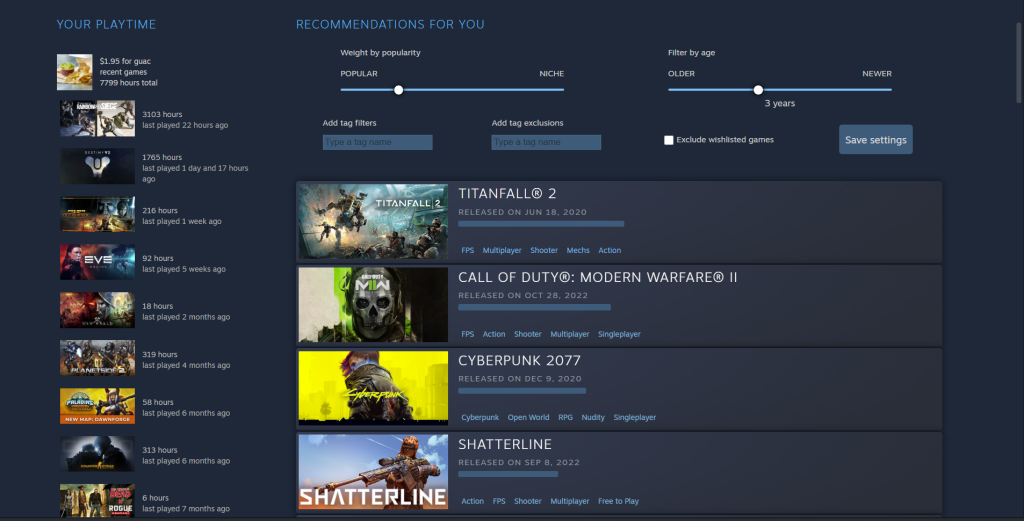
What is Steam?
Launched in 2003, Steam is a digital storefront and distribution platform for users to buy and play video games (“Steam (service),” Wikipedia). Undoubtedly the most successful and widely used video game platform, Steam is not without its issues. Steam recommends users games that they would enjoy using a proprietary recommendation algorithm. Eventually, developers became aware of a method of cheating Steam’s recommendation algorithm which allowed them to promote their games to more users than usual. To fight this issue, Valve designed a new machine-learning based recommendation system for Steam that generated its own data, making it virtually immune to exploitation.
How Were Developers Exploiting the Algorithm?
Steam used to function on a tag-based recommendation system. In this system, developers were able to label their games with genre-based tags (“MMO,” “FPS,” “RPG,” etc.) to describe to potential players the gameplay of their product. Additionally, users were able to expand on what the developers describe with their tags. While developers were able to describe the genre, the community of users on Steam could add more detail about the playing experience with general tags such as “co-op,” “multiplayer,” “singleplayer,” etc. The recommendation algorithm in Steam would recommend to players games that possessed tags similar to those of games that they had played recently or for a large amount of time. Despite developers having a limited scope of how they could tag their games, all it took to get a community tag visible was a few tag suggestions by users. The more unethical developers could easily create new accounts and suggest whatever tags they desired. The most prominent issue with this system was that developers were able to label their games with tags that described the game inaccurately. Although Steam did have a system in which users could report tags to be removed from a product, many users were unaware of that they could vote to remove inaccurate tags, thus its efficacy was limited.
The most common behavior among “profit-driven” developers was labelling their game with all of the most popular tags, even ones that conflicted with each other. This led to almost every user being recommended heaps of “shovelware” quality games; the sheer quantity of tags used to label the game had to be similar to at least one game in a user’s recently played. While AAA games were still found on the platform, indie games were essentially buried under the low quality games because they lacked the similarity of tags that low quality games could find when compared to any user’s library. Overall, the shopping experience was very cluttered and exhausting because of the amount of games that users would have to skip through to reach actual games.
For an example of what an inaccurately tagged game looks like, take a look at the action-racing game “Flatout 3: Chaos & Destruction.”

Users tagged this racing game with horribly inaccurate tags such as nudity, dating sim, and survival horror among others. While it’s not always possible to determine if a game with inaccurate tags was given these tags by the developers, the ability for anyone to mess with the algorithm was an annoyance for all Steam users nonetheless.
Steam’s New Recommendation Algorithm
In July of 2019, Valve made the Interactive Recommender available as an experimental feature for all Steam users. The Interactive Recommender utilizes a new machine learning algorithm to personalize the recommendations that it makes to users. So how does it work? Steam passively tracks the amount of time that users spend playing each game in their library. Using machine learning, the algorithm can take notice of when players of a particular game also spend lots of time playing another. Using these relationships, the algorithm weaves a web between all the games that one plays to create a unique player profile for each user. Players with similar profiles are recommended games from similar “webs” (“Introducing the Interactive Recommender,” Steam Community).

What Issues Does This Algorithm Solve? What Does it Fail to Solve?
The new recommendation system is a major improvement because it removes the emphasis on the metadata of a game determining how it is recommended but rather has the audience of a game speak for itself through playtimes. Valve writes, “The best way for a developer to optimize for this model is to make a game that people enjoy playing”(“Introducing the Interactive Recommender,” Steam Community). It’s no longer up to the developers to push their game to their ideal audience. Instead, they can now focus on selling the most important aspects of their game to the audience their ideal audience that is being recommended the game through the new algorithm.
In addition to the consumers on Steam, indie developers that market their games on Steam are being positively affected by the new recommendation system.

Wait a minute, what if a game doesn’t have a player base? Although Steam’s popularity weight feature helps discover existing indie games, it doesn’t exactly help users discover up and coming games. Because the Interactive Recommender algorithm uses playtime data relationships, games with no playtime are not a part of the algorithm. This can either be because a game hasn’t released or has no players once being released. AAA titles do not typically suffer the issue of lacking discoverability because of their million dollar marketing budget, while indie developers cannot afford to market their game on every media platform. The already existing Discovery Queue feature on Steam provides a place for all games to get started before being used in the Interactive Recommender algorithm. Erik Johnson explains that the Discovery Queue recommends games based on sales, popularity, user reviews, critic reviews, recent release dates, similarity to your games, and copies sold (“A Deep Dive Into Steam’s Discovery Queue 2,” Game Developer).

The Relevance system is a feature of the Discovery Queue that lets users provide feedback on Steam’s recommendation. Users can see up to twelve games a day in their Discovery Queue that Steam picks out for them. Users can skip or ignore games in their queue to shape what the will appear in their queue in the future. Steam provides users with the criteria that it uses to recommend the game into your queue. Although the Discovery Queue mostly recommends trending and recently released games, users are still able to influence what they see. The Discovery Queue still relies on older algorithms, and sometimes incorporates features such as user-generated tags that can come with inaccuracies, but it remains useful tool to help newer games work their way into the Interactive Recommender.
Where Does the Interactive Recommender Stand Now?
The Interactive Recommender remains Steam’s most powerful recommendation tool. Putting the power into the hands of the user, the algorithm provides games loved by users just like them while still allowing the personal customization to search and filter tags, age, popularity. The importance of playtime for games instead of popular tags motivates developers to design games that will welcome players with an enjoyable experience. Both indie and AAA games are able to find their places to shine within the Interactive Recommender system. Despite not incorporating recently released games into the interactive recommender algorithm, the existence of other recommendation features such as the Discovery Queue on the platform ensures that new games aren’t ignored. Steam users are able to enjoy thousands of games enjoyed by players in their community free from the hands of algorithm exploitation.
Works Cited
“Does Flagging Incorrect Tags Even Do Anything? I Flagged These Tags for ‘Flatout 3’ Years Ago and They Are Still There.” Reddit, https://www.reddit.com/r/Steam/comments/q0g76z/does_flagging_incorrect_tags_even_do_anything_i/.
Erik JohnsonBloggerApril 04, 2019. “A Deep Dive into Steam’s Discovery Queue.” Game Developer, 4 Apr. 2019, https://www.gamedeveloper.com/business/a-deep-dive-into-steam-s-discovery-queue.
Kyle Orland – Jul 11, 2019 5:00 pm UTC. “Steam Uses Machine Learning for Its New Game Recommendation Engine.” Ars Technica, 11 July 2019, https://arstechnica.com/gaming/2019/07/steam-turns-to-ai-to-help-users-find-gems-amid-thousands-of-games/.
“Steam (Service).” Wikipedia, Wikimedia Foundation, 22 Nov. 2022, https://en.wikipedia.org/wiki/Steam_(service).
“Steam :: Steam News :: Introducing the Interactive Recommender.” Steam Community, 12 July 2019, https://steamcommunity.com/games/593110/announcements/detail/1612767708821405787.